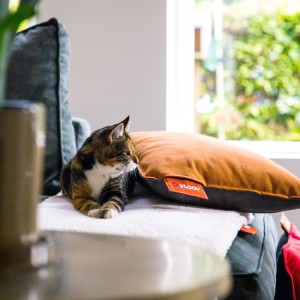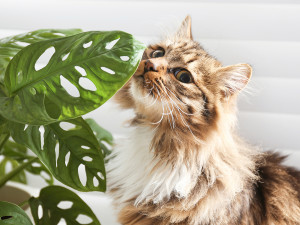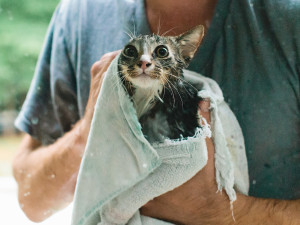
share article
If you’ve ever tried to verbally explain to your cat that it’s too cold or rainy for them to go outside, only for them to cry and scratch at the door while giving you a withering look of betrayal (because, of course, you must be doing this intentionally to spite them), then you’ll be familiar with the guilt that comes from having to decide whether to let your cat brave the cold or deny them adventure and keep them snug indoors. As the January freeze rolls in, understanding a cat’s cold weather tolerance is key to making an informed choice.
Can your cat cope with the cold?
Cats are inherently equipped to handle colder temperatures, thanks to their dense fur coats and natural instincts. Most domestic cats can tolerate temperatures as low as -6C for a few hours (definitely not overnight), while some cold-resistant breeds, like Siberians, Maine Coons and Norwegian Forest cats, can endure even harsher conditions. But even though they can tolerate it, should they?
Factors such as age, health and acclimatisation are important in determining a cat’s cold resilience. Kittensopens in a new tab, senior catsopens in a new tab, or those with health issues – particularly hypothyroidism, renal disease, heart disease and canceropens in a new tab – may struggle in colder temperatures and should stay indoors during winter. And despite the fact many cats can handle cold temperatures, doing so exposes them to the risks of frostbite, encounters with other animals like foxes and badgers that may be more aggressive in the search for warmth, and hypothermia. Signs of moderate to severe hypothermia include mental confusion; dilated pupils; difficulty breathing; muscle stiffness; low blood pressure; a slow heartbeat; and in the most severe cases, slipping into unconsciousness. If you notice any of these signs in your cat after being outside, take them to the vet ASAP.
Additionally, be cautious of ice and snow, as it can accumulate between their paw pads, causing discomfort or injury. Always check your cat’s paws for ice balls after outdoor excursions.
If you do let your cat outside for short periods of time in cold weather, you should provide shelter options like cosy heated bedsopens in a new tab or insulated boxes for them to hunker down in if they need to. And if your house is not equipped with a cat flap, do not let your cat outside if you’re planning on heading out yourself, as even with shelter options it could get too cold for them to be stuck outside for a prolonged period of time. When they do come back in, it’s also essential to monitor their behaviour for signs of cold, such as shivering, sitting in a hunched position or seeking warmth, and if you notice these then take them to a warm spot in the house and reconsider letting them outside in similar temperatures in future.
How to keep your cat occupied indoors
So, you’ve decided it’s best to keep your cat indoors. But now you’ve got a restless cat on your hands who’s pacing around, whining and giving you dirty looks, which can come with its own set of challenges – namely, how to stimulate them and get back in their good books. Here are some tips to engage their curious minds and keep them content indoors.
Interactive playtime
Arguably, the best way to wear your cat out is to engage them with interactive play sessions using toys that mimic prey. Wands, kicker toysopens in a new tab, feather teasers and laser pointersopens in a new tab can simulate hunting experiences and help release some energy while providing physical exercise.
Catnip and puzzle toys
Introducing catnip-infused toys or puzzle feedersopens in a new tab can stimulate your cat’s mind, too. Problem-solving, treats and distraction – it’s a winning combination for both of you.
Vertical spaces
Got a climber on your hands? If you’ve got the room, consider creating some vertical spaces using cat shelves and cat treesopens in a new tab. Not only will they be able to explore, but they’ll also have an elevated perch from which to judge the rest of us mere mortals as we go about our days.
Hide and seek
This game is not just reserved for toddlers and cunning parents who want two minutes of peace. You can also hide treats or small toysopens in a new tab around the house for your cat to discover. This taps into their natural hunting instincts and provides a reward at the end of their search.
Training and tricks
Yes, contrary to popular belief, cats can be trainedopens in a new tab, too. From high-fivesopens in a new tab to sit and even fetchopens in a new tab, there are plenty of tricks you can work on with your cat to keep them mentally stimulated and strengthen your bond.
Window watching
For the cat who really misses the outside world, you can set up a cosy perch or cat hammockopens in a new tab by the window to give them a front-row seat to their territory, but with the added benefit of warmth. Watching birds, squirrels or even just passing cars can be entertaining and keep them occupied. If you don’t have a good window spot, you can fake it with TV for catsopens in a new tab.
Quality time
Let’s face it, this time of year lends itself very nicely to snuggling up in bed, making cups of tea and bingeing your favourite comfort shows. And who better to enjoy it with than your cat?
Despite their cold resistance, keeping cats indoors during extreme weather conditions is the sensible choice. So, while some cats may enjoy a romp in the snow or run in the rain, most prefer the warmth of the hearth, you and your bed. This winter, activate chill mode, minus the chill factor.

Ro Elfberg
Ro is The Wildest’s Senior Editor. She has previously written and copy-edited for British Vogue, Glamour and DICE. When she’s not being manipulated into dishing out Dreamies to Kobe the cat, she spends her free time trying to convince her snake, Butters, to wear a tiny hat.
Related articles
![woman with dark hair lying in bed with striped cat, both asleep]() opens in a new tab
opens in a new tabShould Your Cat Sleep With You?
Here are the pros and cons of having a feline sleeping buddy
![cat lying on cushion]() opens in a new tab
opens in a new tab7 Heated Cat Beds to Keep Your Feline Warm This Winter
Because your cat deserves to be cosy, too
![cat sniffing a plant]() opens in a new tab
opens in a new tab9 Plants Toxic to Cats
These plants might be beautiful, but they’re deadly to feline foragers
![A cat headbutting a woman on her laptop.]() opens in a new tab
opens in a new tabWhy Does Your Cat Headbutt You? Curious Cat Behaviour Explained
Apparently, you should take it as a compliment
![cat playing fetch]() opens in a new tab
opens in a new tabHow to Train a Kitten to Fetch
Move over, pups. This is a cat’s game, too
![cat wrapped in towel after bath]() opens in a new tab
opens in a new tabSelf-Care Sunday For Cats
How to bathe a cat, step by step





